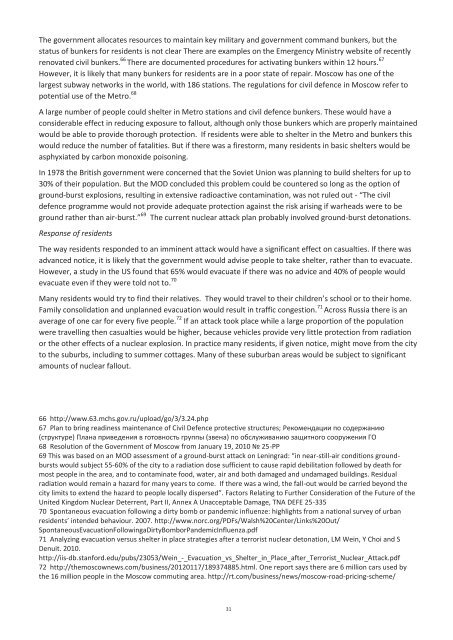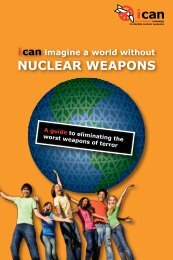If Britain fired Trident - International Campaign to Abolish Nuclear ...
If Britain fired Trident - International Campaign to Abolish Nuclear ...
If Britain fired Trident - International Campaign to Abolish Nuclear ...
- No tags were found...
Create successful ePaper yourself
Turn your PDF publications into a flip-book with our unique Google optimized e-Paper software.
The government allocates resources <strong>to</strong> maintain key military and government command bunkers, but thestatus of bunkers for residents is not clear There are examples on the Emergency Ministry website of recentlyrenovated civil bunkers. 66 There are documented procedures for activating bunkers within 12 hours. 67However, it is likely that many bunkers for residents are in a poor state of repair. Moscow has one of thelargest subway networks in the world, with 186 stations. The regulations for civil defence in Moscow refer <strong>to</strong>potential use of the Metro. 68A large number of people could shelter in Metro stations and civil defence bunkers. These would have aconsiderable effect in reducing exposure <strong>to</strong> fallout, although only those bunkers which are properly maintainedwould be able <strong>to</strong> provide thorough protection. <strong>If</strong> residents were able <strong>to</strong> shelter in the Metro and bunkers thiswould reduce the number of fatalities. But if there was a fires<strong>to</strong>rm, many residents in basic shelters would beasphyxiated by carbon monoxide poisoning.In 1978 the British government were concerned that the Soviet Union was planning <strong>to</strong> build shelters for up <strong>to</strong>30% of their population. But the MOD concluded this problem could be countered so long as the option ofground-burst explosions, resulting in extensive radioactive contamination, was not ruled out - “The civildefence programme would not provide adequate protection against the risk arising if warheads were <strong>to</strong> beground rather than air-burst.” 69 The current nuclear attack plan probably involved ground-burst de<strong>to</strong>nations.Response of residentsThe way residents responded <strong>to</strong> an imminent attack would have a significant effect on casualties. <strong>If</strong> there wasadvanced notice, it is likely that the government would advise people <strong>to</strong> take shelter, rather than <strong>to</strong> evacuate.However, a study in the US found that 65% would evacuate if there was no advice and 40% of people wouldevacuate even if they were <strong>to</strong>ld not <strong>to</strong>. 70Many residents would try <strong>to</strong> find their relatives. They would travel <strong>to</strong> their children’s school or <strong>to</strong> their home.Family consolidation and unplanned evacuation would result in traffic congestion. 71 Across Russia there is anaverage of one car for every five people. 72 <strong>If</strong> an attack <strong>to</strong>ok place while a large proportion of the populationwere travelling then casualties would be higher, because vehicles provide very little protection from radiationor the other effects of a nuclear explosion. In practice many residents, if given notice, might move from the city<strong>to</strong> the suburbs, including <strong>to</strong> summer cottages. Many of these suburban areas would be subject <strong>to</strong> significantamounts of nuclear fallout.66 http://www.63.mchs.gov.ru/upload/go/3/3.24.php67 Plan <strong>to</strong> bring readiness maintenance of Civil Defence protective structures; Рекомендации по содержанию(структуре) Плана приведения в готовность группы (звена) по обслуживанию защитного сооружения ГО68 Resolution of the Government of Moscow from January 19, 2010 № 25-PP69 This was based on an MOD assessment of a ground-burst attack on Leningrad: “in near-still-air conditions groundburstswould subject 55-60% of the city <strong>to</strong> a radiation dose sufficient <strong>to</strong> cause rapid debilitation followed by death formost people in the area, and <strong>to</strong> contaminate food, water, air and both damaged and undamaged buildings. Residualradiation would remain a hazard for many years <strong>to</strong> come. <strong>If</strong> there was a wind, the fall-out would be carried beyond thecity limits <strong>to</strong> extend the hazard <strong>to</strong> people locally dispersed”. Fac<strong>to</strong>rs Relating <strong>to</strong> Further Consideration of the Future of theUnited Kingdom <strong>Nuclear</strong> Deterrent, Part II, Annex A Unacceptable Damage, TNA DEFE 25-33570 Spontaneous evacuation following a dirty bomb or pandemic influenze: highlights from a national survey of urbanresidents’ intended behaviour. 2007. http://www.norc.org/PDFs/Walsh%20Center/Links%20Out/SpontaneousEvacuationFollowingaDirtyBomborPandemicInfluenza.pdf71 Analyzing evacuation versus shelter in place strategies after a terrorist nuclear de<strong>to</strong>nation, LM Wein, Y Choi and SDenuit. 2010.http://iis-db.stanford.edu/pubs/23053/Wein_-_Evacuation_vs_Shelter_in_Place_after_Terrorist_<strong>Nuclear</strong>_Attack.pdf72 http://themoscownews.com/business/20120117/189374885.html. One report says there are 6 million cars used bythe 16 million people in the Moscow commuting area. http://rt.com/business/news/moscow-road-pricing-scheme/31






